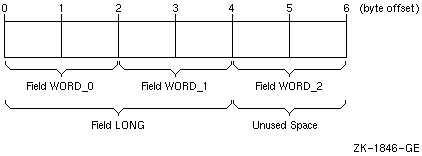
A union declaration is a multistatement declaration defining a data area that can be shared intermittently during program execution by one or more fields or groups of fields. A union declaration must be within a structure declaration.
Each unique field or group of fields is defined by a separate map declaration.
A union declaration takes the following form:
As with normal Fortran type declarations, data can be initialized in field declaration statements in union declarations. However, if fields within multiple map declarations in a single union are initialized, the data declarations are initialized in the order in which the statements appear. As a result, only the final initialization takes effect and all of the preceding initializations are overwritten.
The size of the shared area established for a union declaration is the size of the largest map defined for that union. The size of a map is the sum of the sizes of the fields declared within it.
Manipulating data by using union declarations is similar to using EQUIVALENCE statements. The difference is that data entities specified within EQUIVALENCE statements are concurrently associated with a common storage location and the data residing there; with union declarations you can use one discrete storage location to alternately contain a variety of fields (arrays or variables).
With union declarations, only one map declaration within a union declaration can be associated at any point in time with the storage location that they share. Whenever a field within another map declaration in the same union declaration is referenced in your program, the fields in the prior map declaration become undefined and are succeeded by the fields in the map declaration containing the newly referenced field.
Examples
In the following example, the structure WORDS_LONG is defined. This structure contains a union declaration defining two map fields. The first map field consists of three INTEGER*2 variables (WORD_0, WORD_1, and WORD_2), and the second, an INTEGER*4 variable, LONG:
STRUCTURE /WORDS_LONG/
UNION
MAP
INTEGER*2 WORD_0, WORD_1, WORD_2
END MAP
MAP
INTEGER*4 LONG
END MAP
END UNION
END STRUCTURE
The length of any record with the structure WORDS_LONG is 6 bytes. Figure B-2 shows the memory mapping of any record with the structure WORDS_LONG:
Figure B-2 Memory Map of Structure WORDS_LONG
